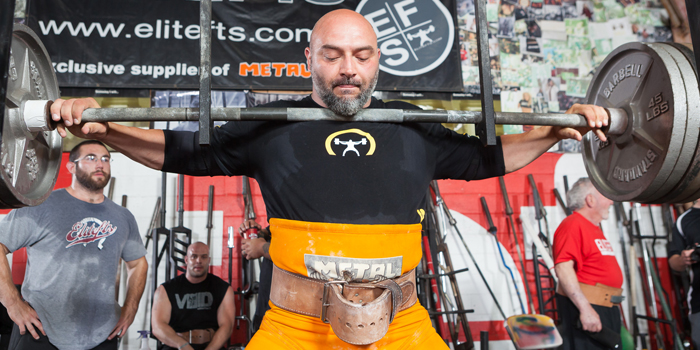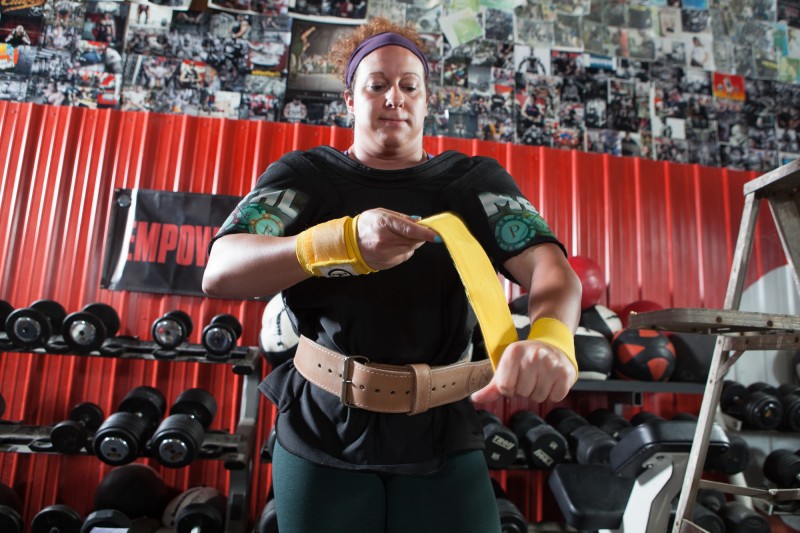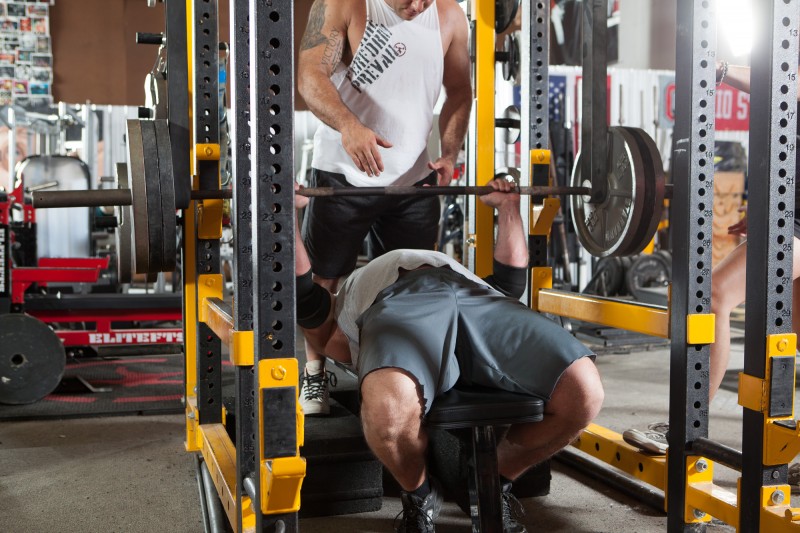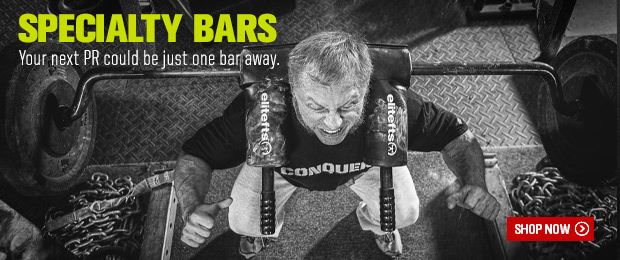
This is Part 1 of a series on my take on conjugate, Westside, concurrent, or whatever the heck everyone is calling it these days. What I am talking about is the four-day per week rotation consisting of two max effort days and two dynamic effort days developed and popularized by Louie Simmons. There are many articles on elitefts about this method. This is my interpretation, adaptation, and application of it.
The max effort method is, in my opinion, the part of the system most often misinterpreted and overcomplicated. That's where I'll get things going.
With max effort work, the goal is to lift a maximal load with a special exercise in order to develop inter- and intramuscular coordination. What does that really mean? It means that you are training a variation of the main lifts that are very heavy in order to improve your ability to strain under something at or very near to your top end. Sounds pretty simple, right?
RECENT: Make Box Squats Work for a Stronger Raw Squat
Even if the general definition of max effort work is simple enough, there is a lot of room left for interpretation. What exercise should you train? What rep range should you train? How do you rotate things?
These principles will help you find some answers:
Principle 1: Keep It Simple
With max effort work (and the inherent going as heavy as possible each week), you need to rotate the exercises you’ve trained to avoid stagnation and regression. In other words, if you hit a top single on the same lift each week, your numbers will eventually start going backward. Switching the lift each week will prevent burn out.
Switching exercises can be accomplished pretty easily. For squats, you could start by bringing your stance in or out — new exercise. Add a pause — new exercise. Change the bar — new exercise. Add a box — new exercise. Change the box height — Guess what? Another new exercise.

Where many lifters get lost is overcomplicating things when switching variations. If you're doing a Swiss Bar reverse banded chained two-board press in a Slingshot with a three-count pause, how do you know what is affecting what? How do you know how all those variables are going to interplay? How are you going to gain any applicable knowledge for your competition bench? I wouldn’t have a clue what is doing what. If anything, unless you have good reason for doing so, too many variables will make the lift have less value. Your goal is to switch the variation just enough to create a new stimulus, not to lose any semblance of specificity.
A criticism of max effort work is that it isn't specific enough to competition powerlifts because you aren't training the lifts themselves. This criticism is perpetuated when lifters aren't training anything close to their competition lift for 12 weeks and then underperform at the meet.
What's the solution? Keep it simple.
It's easy to change the lift every week without having to throw in every variable in the book. Adding unnecessary complexity to a lift isn’t going to add any benefit. Regardless of any variables, it is the effort you put into a lift, not the variation you are doing, that counts on max effort day.
For simplicity, a general rule I suggest is to limit the changes from a comp lift to two variables (as with all rules there can be exceptions). In application, this would look like:
- Specialty bar + a box;
- Specialty bar + a band;
- Stance change + a box;
- Stance change + a band; or
- Any sort of combination of that sort.
RELATED: 230 Max Effort Variations You Can Do With 1 Bar
Even with limiting yourself to two variables, you'll have more variations than you know what to do with.
Principle 2: Get an Adequate Amount of Volume In
Prilepin's Chart states if you are training above 90 percent, the optimal number of reps to hit is four. Since I'm not one to be concerned with exact percentages in application, I like to shoot for two to four working reps on a max effort day. What does that end up looking like? In a perfect world, it’d like something like a single at 90 to 92 percent; a single at 95 to 97 percent; a single at 99 to 100 percent; and a new PR. In the real world, this will look like a handful of hard singles before an all-out top set or one all-out heavy triple.
Taking smaller jumps may limit the absolute load that you can handle, but that could be to your advantage. First, it's the strain that matters on max effort day, not the absolute number. If that number ends up being a little bit lower each week, you're going to stay that little bit fresher as the weeks go on. Second, smaller jumps mean more chances to dial things in and learn under heavy weights. Third, if you're used to taking multiple small jumps in training, on meet day when you take optimal jumps, you'll be fresh to smoke your third and in shape to help overcome any potential mistakes.
With that, for advanced lifters, I like training singles only on max effort day Why? Fewer reps mean a lower likelihood of things going sideways — There are fewer reps per set to be impacted by the fatigue that will increase with each rep.

For intermediate lifters, I like to get them to train triples. Why? The biggest reason is that they aren't yet familiar with putting absolutely everything they can into a set. They won't get adequate stimulus out of a single because they won't be able to load it enough without breaking form. A heavy triple will better ensure that adequate stimulus is there.
Principle 3: The Goal Isn't to Die
The goal is to strain. Not to grind for 14 seconds, convulse, miss multiple reps, tear muscle off the bone, or headbutt the wall for 10 minutes to get psyched up enough for your top set. Good solid hard reps where your form doesn't break down are going to benefit you in the long-term. Good reps are going to build more good reps. Practicing shitty reps will build the habit of performing shitty reps. If you go so heavy on max effort work that your form breaks or you miss reps, you aren't doing yourself any favors.
Max effort work is about finding the very fine line where it is heavy and where you are straining hard, but you are still in the driver's seat. You don't need Jesus to take the wheel for a training stimulus. Basically, you want to end up with what looks like a perfectly selected third attempt on meet day.
How do you make this happen? Take smart attempts. Only make an attempt if you know it is there. Don't go up if the last rep broke down, and there's nothing you can do about it. Don't go up if something felt off on the last rep, and you can't put your finger on what was wrong. Don't go up if you felt a slight pull on the last rep. To reiterate: Only go up if it's the smart choice.
Principle 4: Don't Overuse the Overload
When you start playing with accommodating resistance or altering the range of motion, you are going to handle more weight than you could on a competition variation. You will reverse band bench more than you can bench. No one can argue that. The same goes for a four-board press versus full range.
READ MORE: Everything You Need to Know About The Max Effort Method
Overloading does have its place and can be a very powerful training stimulus, but I am of the opinion that it shouldn't be done all the time. Furthermore, when it is done, it shouldn't be done in a manner that adds too much over what you can actually handle.
In order to overload a movement, the hardest part of the movement has to be made easier. It is either going to become physically lighter where the lift is the hardest (accommodating resistance), or you are going to skip the hardest part of the movement altogether (partial range).
When you are making the hardest part of the lift easier, you are essentially taking away the training stimulus where you are at the biggest disadvantage. If you rarely train where you are disadvantaged in a movement, do you expect to get better at the movement itself?
Lightening the bottom end or reducing the range of motion can help to keep you fresher, but at the same time, if you end up handling too much weight too often before you are built up to do it, it can have the opposite effect.
To combat the above, I work underloading exercises into the rotation. I'll use exercises that are harder than the comp lifts in conjunction with the ones that allow you to handle more. The underloading exercises will expose where you are weak and limit the number on the bar.
When you underload, you still will achieve the primary goal of straining, and you will reduce the overall load on your system. When you overload, you will be giving your joints a break where they are subject to the most risk while preparing yourself to handle heavier weights in the future. Rotating overloading and underloading into your max effort lifts through a training cycle will let you train what you need when you need it.
In Conclusion
In my opinion, conjugate is one of, if not, the best training systems — when employed properly. If it isn't working, don't disregard the system; instead, check your application. Think about what you are doing and what you are trying to accomplish on the day. On max effort day, the most important thing is that you are straining against something heavy. If you are accomplishing that, you are on the right track.
These four principles have kept and my training partners and me from getting lost in the max effort method.
Seth Albersworth is a powerlifter with experience in and out of gear. His best totals are 2,000 pounds raw and 2,403 pounds multi-ply. Seth has completed his bachelor's degree in kinesiology from the University of Calgary and is currently studying to become a Doctor of Chiropractic at Palmer College of Chiropractic's Florida Campus.











If I need a lighter week I'll often use a SSB and squat to a low box, do a low suspended goodmorning, or pull from a block height that is very awkard for me. All three will reduce the overall weight on the bar, while still alowing me to train with maximal intensity.